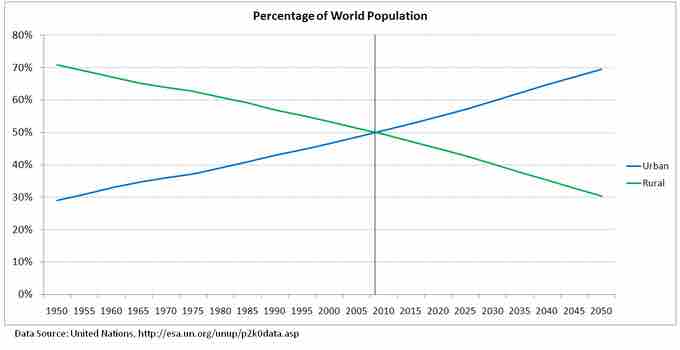Urbanization and rural flight
Urbanization is the process of a population shift from rural areas to cities. During the last century, global populations have urbanized rapidly:
- 13% of people lived in urban environments in the year 1900
- 29% of people lived in urban environments in the year 1950
One projection suggests that, by 2030, the proportion of people living in cities may reach 60%.

Rural and Urban World Population
Over time, the world's population has become less rural and more urban.
Urbanization tends to correlate positively with industrialization. With the promise of greater employment opportunities that come from industrialization, people from rural areas will go to cities in pursuit of greater economic rewards.
Another term for urbanization is "rural flight. " In modern times, this flight often occurs in a region following the industrialization of agriculture—when fewer people are needed to bring the same amount of agricultural output to market—and related agricultural services and industries are consolidated. These factors negatively affect the economy of small- and middle-sized farms and strongly reduce the size of the rural labor market. Rural flight is exacerbated when the population decline leads to the loss of rural services (such as business enterprises and schools), which leads to greater loss of population as people leave to seek those features.
As more and more people leave villages and farms to live in cities, urban growth results. The rapid growth of cities like Chicago in the late nineteenth century and Mumbai a century later can be attributed largely to rural-urban migration. This kind of growth is especially commonplace in developing countries.
Urbanization occurs naturally from individual and corporate efforts to reduce time and expense in commuting, while improving opportunities for jobs, education, housing, entertainment, and transportation. Living in cities permits individuals and families to take advantage of the opportunities of proximity, diversity, and marketplace competition. Due to their high populations, urban areas can also have more diverse social communities than rural areas, allowing others to find people like them.
Economic and Environmental Effects of Urbanization
Urbanization has significant economic and environmental effects on cities and surrounding areas. As city populations grow, they increase the demand for goods and services of all kinds, pushing up prices of these goods and services, as well as the price of land. As land prices rise, the local working class may be priced out of the real estate market and pushed into less desirable neighborhoods - a process known as gentrification.
Growing cities also alter the environment. For example, urbanization can create urban "heat islands," which are formed when industrial and urban areas replace and reduce the amount of land covered by vegetation or open soil. In rural areas, the ground helps regulate temperatures by using a large part of the incoming solar energy to evaporate water in vegetation and soil. This evaporation, in turn, has a cooling effect. However in cities, where less vegetation and exposed soil exists, the majority of the sun's energy is absorbed by urban structures and asphalt. During the day, cities experience higher surface temperatures because urban surfaces produce less evaporative cooling. Additional city heat is given off by vehicles and factories, as well as industrial and domestic heating and cooling units. Together, these effects can raise city temperatures by 2 to 10 degrees Fahrenheit (or 1 to 6 degrees Celsius).
Suburbanization and Counterurbanization
Recently in developed countries, sociologists have observed suburbanization and counterurbanization, or movement away from cities. These patterns may be driven by transportation infrastructure, or social factors like racism. In developed countries, people are able to move out of cities while still maintaining many of the advantages of city life (for instance, improved communications and means of transportation). In fact, counterurbanization appears most common among the middle and upper classes who can afford to buy their own homes.
Race also plays a role in American suburbanization. During World War I, the massive migration of African Americans from the South resulted in an even greater residential shift toward suburban areas. The cities became seen as dangerous, crime-infested areas, while the suburbs were seen as safe places to live and raise a family, leading to a social trend known in some parts of the world as "white flight. " Some social scientists suggest that the historical processes of suburbanization and decentralization are instances of white privilege that have contributed to contemporary patterns of environmental racism.
In the United States, suburbanization began in earnest after World War II, when soldiers returned from war and received generous government support to finance new homes. Suburbs, which are residential areas on the outskirts of a city, were less crowded and had a lower cost of living than cities. Suburbs grew dramatically in the 1950s when the U.S. interstate highway system was built, and automobiles became affordable for middle class families. Around 1990, another trend emerged known as counterurbanization, or "exurbanization". The wealthiest individuals began living in nice housing far in rural areas (as opposed to forms).
Suburbanization may be a new urban form.Rather than densely populated centers, cities may become more spread out, composed of many interconnected smaller towns. Interestingly, the modern U.S. experience has gone from a largely rural country, to a highly urban country, to a country with significant suburban populations.